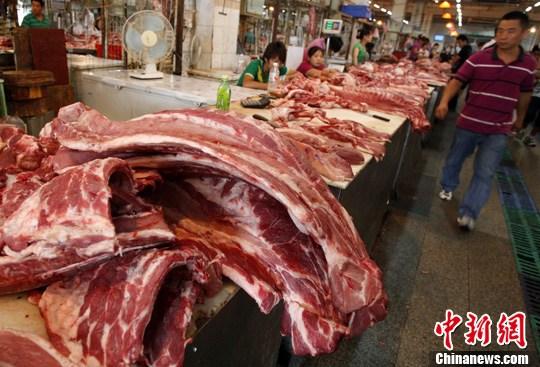
Pork is sold at a market. (File photo/Chinanews.com)
China's per capita meat consumption could drastically increase in the next 20 years as the rise in resident income is expected to put tremendous strain on the country's agricultural supply chains, according to a report issued by an international food policy think tank.
The Global Food Policy Report 2016, released by the International Food Policy Research Institute in Beijing on Monday, said China's per capita annual meat consumption, now at 59 kilograms, is already double the world average.
The per capita meat consumption could increase to 74 kilograms, which is in line with Taiwan and Hong Kong, in the future, the report said. It added that the trend is replicated across other East Asian countries, with regional per capita meat consumption expected to double over the next two decades.
"Such rapid growth is expected to put a tremendous strain on agricultural supply chains as countries adapt to the growing role of livestock," the report said.
The report added that to produce so much meat to feed such a large population in East Asia would require an amount of feed corn nearly equal to all of the current output of Brazil and Argentina.
It said while the current demand for feed grains is largely met by imports, how growing demands will be met in the future is an important question.
The report also warned that feeding almost 30 percent of the world's population will become more difficult for East Asian countries as they face rapidly changing diets along with climate change.
The Sustainable Development Goals, adopted by the United Nations in September 2015, has set the target of eradicating hunger and undernutrition in 15 years or less.
"This report shows that if we are to meet these goals, we have a lot of work ahead. We must promote and support a new global food system that is efficient, inclusive, climate-smart, sustainable, nutrition- and health-driven, and business-friendly in order to ensure that no one goes to sleep hungry," said Fan Shenggen, director general of the Washington DC-based institute. The global rice price is expected to continue to decrease in 2016 as a result of low demand for regular rice importers, the report said.
It said the increase in stockpile of rice to meet the goals of self-sufficiency among the largest rice importers, including China, could further drive down the rice prices in the global market.
The large stockpiles in Thailand and the fact that the full impact of El Nino is not expected until mid-2016 will also be adverse factors for the increase in rice price.
Rice harvests over the past few years have been unremarkable and inventories are expected to hit a new low in 2016.
Fan said ensuring that these farmers have the resources they need to increase resilience not only safeguards food security among the region's poorest populations, but also contributes broadly to the sustainable development goals, including poverty, hunger, gender equality, clean water, and climate action.


















































